Triângulo de Bonwill e sua relação com o gênero e o tipo de oclusão dos pacientes
DOI:
https://doi.org/10.14295/bds.2008.v11i1.226Abstract
O triângulo de Bonwill (TB) é formado por linhas imaginárias unindo: o ponto interincisivo (PI), o côndilo direito (CD) e o esquerdo (CE). O objetivo foi relacionar o TB com o gênero das pessoas e o tipo de oclusão, testando a hipótese de que o tipo de oclusão altera as medidas desse triângulo. Foram examinadas 140 pessoas (P), sendo 56 homens (H) e 84 mulheres (M), entre 18 e 32 anos, que tiveram o tipo de oclusão determinada (Angle). Os registros do PI e da distância intercondilar foram realizados pelo arco facial (Bio-art). As medidas entre PI-CE-CD foram registradas e os valores analisados estatisticamente usando Anova e Tukey (á=0,05). A oclusão tipo I ocorreu em 97P (42H e 55M), a tipo II-1 em 35P (10H e 25M), a tipo II-2 em 6P (3H e 3M) e a tipo III em 2P (1H e 1M). Levando em consideração o sexo das P, as distâncias médias (mm) entre os 3 pontos foram: H= 124.7±7.8a; 121.9±4.5b; 121.5±4.5b e M=117.8±4.7A; 114.8±4.6B; 114.5±4.2B. Considerando o tipo de oclusão: I=120.3±7.3; 118.1±5.6; 117.8±5.5; II-1= 120.8±6.3; 116.1±5.8; 116.1±5.5; II-2= 122.1±6.3; 118.3±5.9; 117.8±4.3; III= 121.5±4.9; 116.5±10.6; 115.0±11.3. Houve diferença significante entre as 3 medidas dos H e M e entre as mesmas medidas nos H e nas M (p<0,05), sugerindo que o TB não é eqüilátero e é diferente para H e M, na população estudada. Considerando a amostragem, o tipo de oclusão não influenciou significativamente na medida dos lados do triângulo (p>0,05), rejeitando a hipótese inicial.
Downloads
Downloads
Published
How to Cite
Issue
Section
License
Brazilian Dental Science uses the Creative Commons (CC-BY 4.0) license, thus preserving the integrity of articles in an open access environment. The journal allows the author to retain publishing rights without restrictions.
=================




























